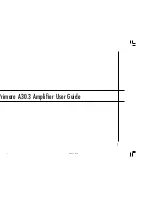
CIRCUIT DESCRIPTION
13
DIFFERENTIAL LOW-NOISE
FRONT END
Two high-impedance inputs A and B allow
the instrument to operate in either single-
ended or true differential modes. Relays
K103 and K104 allow the inputs A and B to
be individually grounded, while K101 selects
AC or DC coupling. Inversion of the inputs
is provided by relay K105. The input
capacitances and R101 and R102 establish
the front end's input impedance at 25 pF
and 100 M
Ω
.
U106 is an NPD5564 low-noise matched
FET pair, which, along with U102 and U103
form the first differential amplifier stage.
U102 compares the currents in the drain
loads of U106, and U103 maintains the sum
of those currents at a fixed level by varying
the total current in both FETs. C109
provides open-loop compensation for U102,
and front-end gain is nominally established
by the sum of R118 and R112 over the sum
of R114 and R128. K102 is a gain switching
relay which selects a front end gain of 2 or
10. In the gain of 2 position, gain to the
next stage becomes 1 when R116 divides
with the input attenuator to the next stage.
For a gain of 10, relay K102 shorts the top
of R115 and R128 together, essentially
eliminating them from the gain loop. P103
allows adjustment of front-end offset, and
P104 allows for offset compensation when
in the low gain configuration. P102 allows
adjustment of the front-end common-mode
rejection ratio, along with P101, which
adjusts the CMRR in the low gain
configuration.
In the second gain stage, U105 is
configured with a fixed gain of 10. By
switching the input attenuation of this stage
with DG444 U101, the overall gain of this
stage can be computer selected as 2, 5, or
10. C111 provides high frequency
compensation for U105. The output of this
stage passes through all three sections of
U104, a CMOS multiplexer that serves as
the blanking control. The three parallel
switches provide a low "on" resistance to
select either the output of the second stage
amplifier or ground as the input to the next
stage, the first filter section.
CONFIGURABLE FILTERS AND
GAIN
The two filter stages in the SR560 each
consist of 16 R-C filters which can be
configured as either high pass or low pass
by a relay. In the following description, part
references in parentheses refer to filter two.
Relay K201, (K301) selects either the high-
pass or low-pass configuration for all of the
sixteen filters. The output of one R-C
section is selected by multiplexer U202 or
U203, (U301 or U302) and passed on to
non-inverting buffer U202, (U303).
Approximately 80 pF input capacitance of
the multiplexers is included in the
calculation of the R-C time constants of the
filters. The four highest frequency stages
are not available as high-pass filters
because of unacceptable attenuation of the
signal that occurs when the filter
capacitance forms a divider with the input
capacitance of the multiplexers.
DG444 U205D, (U401A) is used to bypass
the filter sections entirely and U101D,
(U304D) is used to "reset" the filter stages
by discharging them through R228, (R329).
U201, (U305) is the third, (fourth) gain stage
with a fixed gain of 5. The input attenuator
U205, (U304) allows setting the gain of
these stages to 1, 2, or 5 under computer
control.
OUTPUT STAGES
The fifth gain stage consists of op-amp
U402 which is configured as a non-inverting
amplifier with a gain of 5. U401 is a DG444
that again serves to switch the input
attenuation of this stage for overall gains of
1, 2, or 5. Additionally, output offset
Содержание SR560
Страница 2: ......
Страница 8: ...4...
Страница 10: ...SPECIFICATIONS 6...
Страница 26: ...APPENDIX A A 2...
Страница 30: ...APPENDIX B B 4...
Страница 44: ...SR560 COMPONENT PARTS LIST C 14...
















































